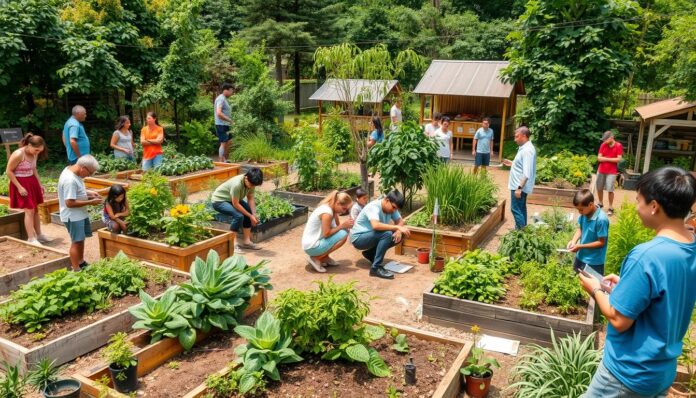What if the secret to great permaculture education is knowing how students learn best? Tailoring teaching to fit each student’s needs is key. Permaculture learning styles help create a great learning space. By using holistic and sustainable teaching methods, educators can help students really get permaculture.
As we dive into permaculture education, we need to think about how to teach in ways that work for everyone. This makes learning more inclusive and effective for all.
Key Takeaways
- Permaculture learning styles are crucial in creating an effective learning environment
- Holistic learning approaches and sustainable learning practices are essential in permaculture education
- Understanding different learning styles can help educators tailor their teaching methods
- Permaculture education can benefit from a student-centered approach
- Effective permaculture education requires a deep understanding of the diverse learning styles of students
- Permaculture learning styles can be optimized through hands-on practice and real-world applications
Introduction to Learning Styles in Permaculture
Permaculture education focuses on interactive and hands-on learning. It caters to different learning styles, making lessons engaging for all. Through real-world projects, students learn permaculture in a meaningful way.
Learning is more effective when it’s hands-on. Permaculture education resources show that interactive lessons are key. They help students grasp permaculture better.
- Increased student engagement and participation
- Improved retention of information and skills
- Enhanced ability to apply permaculture principles in real-world situations
Interactive lessons and hands-on projects make learning fun. This approach boosts understanding and inspires students. It encourages them to live sustainably and care for the environment.
The Role of Permaculture Principles in Learning
Permaculture design principles are key in making learning outcomes rich and meaningful. They help students see their potential as change makers in their communities. By using permaculture in education, teachers can make learning more engaging and effective.
Hands-on permaculture training is crucial. It lets students use what they learn in real situations. This way, they get a better grasp of permaculture and how it works in the world. Learning should be tailored to each student’s needs and how they learn best.
- Reduced soil erosion and improved soil health
- Promoted biodiversity through diverse ecosystems
- Minimized water usage and enhanced soil water retention
By adding permaculture to education, we can make learning more sustainable and effective. This prepares students to tackle the big challenges of today’s world.
Identifying Different Learning Styles
It’s key to know the different ways people learn in permaculture. Kolb says there are four main styles: Diverging, Assimilating, Converging, and Accommodating. In permaculture, we see learners as visual, auditory, or kinesthetic.
Visual Learners
Visual learners get information best from images, diagrams, and videos. Workshops can help them by using multimedia and hands-on activities. This way, they can see how permaculture works in real life.
Auditory Learners
Auditory learners like learning through sound and music. To help them, we use podcasts, audio lectures, and group talks. This way, they can connect with the material in their own way.
Kinesthetic Learners
Kinesthetic learners learn by doing things with their hands. Workshops offer them chances to garden, compost, and build naturally. This hands-on approach helps them understand permaculture better.
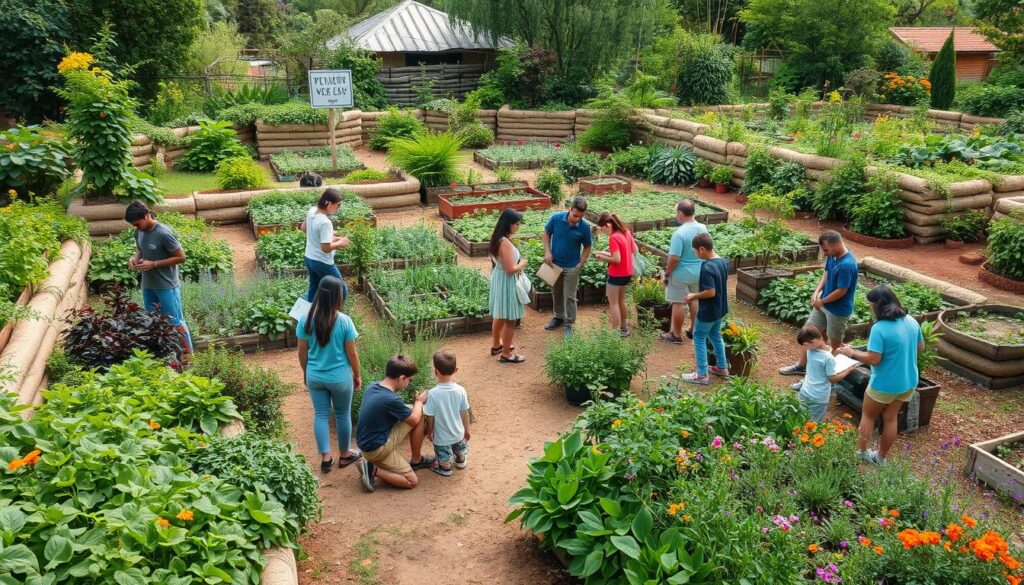
By understanding and meeting different learning styles, we make learning better for everyone. This way, everyone can learn in a way that feels right for them. It helps them grasp permaculture more deeply.
Permaculture Teaching Methods
Permaculture education comes in many forms, like hands-on workshops, online courses, and community gardens. These methods help students learn in a practical way. They make learning more fun and effective by using experiential learning techniques.
Some key benefits of these methods are:
- Hands-on experience with permaculture principles and practices
- Opportunities for feedback and guidance from experienced instructors
- Access to a community of like-minded individuals who share similar interests and goals
Using diverse learning strategies helps educators reach different learning styles. This makes learning more inclusive and engaging. It helps students understand and apply permaculture in their lives.
Tailoring Education for Diverse Learners
Personalized permaculture learning is key to a great learning space. It helps teachers meet the needs of all students. This means using methods that fit each student’s learning style.
Interactive permaculture lessons are a great way to do this. They make learning fun and help students really get it.
Holistic learning is also important in permaculture education. It teaches students about how everything in nature is connected. This is done through activities like building sustainable gardens.
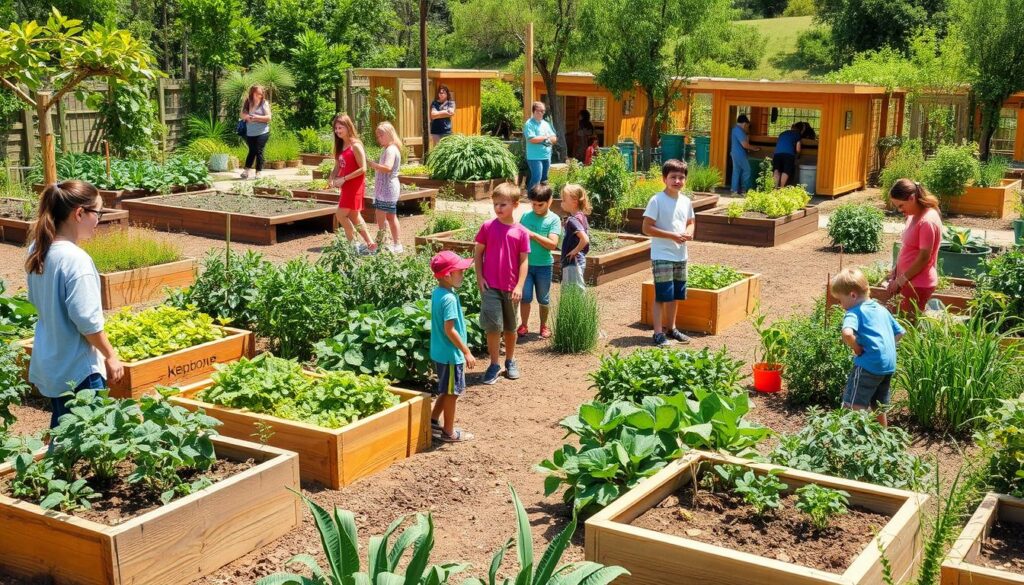
- Make the curriculum fit each student’s needs.
- Set up learning spaces that work for everyone.
- Use different teaching methods, like pictures, sounds, and hands-on activities.
Using these strategies helps teachers make learning better for everyone. It makes students more engaged and successful in their studies.
The Importance of Experiential Learning
Experiential learning is key in permaculture education. It lets students learn by doing, not just reading. Hands-on permaculture training helps students grasp permaculture principles better. They see how these principles work in real life.
Experiential learning techniques like outdoor labs and workshops make learning fun. They keep students interested and help them remember what they learn. About 70% of students say they understand better when they get to do things.
Sustainable learning practices are also important. They teach students to care for the environment. By using experiential learning, teachers can make learning more fun and effective. Some benefits include:
- Increased retention rates by up to 75%
- Improved understanding of concepts through hands-on experience
- Enhanced environmental awareness and responsibility
Experiential learning is essential in permaculture education. It gives students the skills and knowledge to make a difference in their communities.
| Benefits of Experiential Learning | Percentage Increase |
|---|---|
| Retention Rates | 75% |
| Understanding of Concepts | 70% |
| Environmental Awareness | 60% |
Collaborative Learning in Permaculture
Collaborative learning is key in permaculture education. It lets students share knowledge and skills. By working together, they gain a deeper understanding of permaculture. Permaculture ethics in public education highlight the value of community and cooperation.
Interactive permaculture workshops are great for learning together. They offer a hands-on way to learn. These workshops can meet different learning needs, making sure everyone can participate.
Some benefits of learning together in permaculture include:
- Shared knowledge and skills
- Improved problem-solving and critical thinking
- Enhanced communication and teamwork
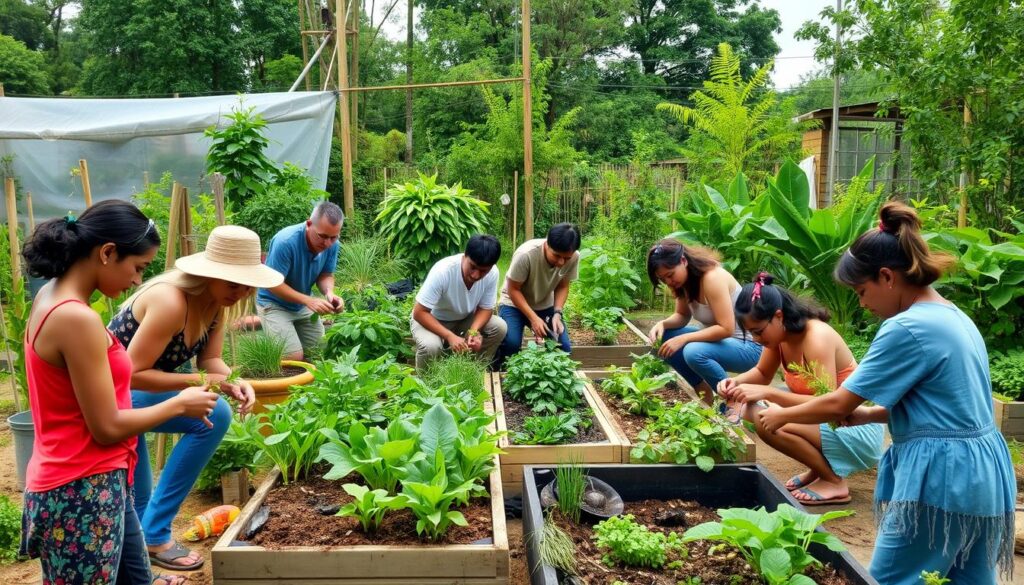
By using collaborative learning, educators can make learning more engaging. This approach helps students understand and apply permaculture in real life. It leads to a more sustainable and fair future.
Incorporating Technology in Permaculture Education
Permaculture education is changing with new methods. Now, it includes interactive lessons and hands-on learning. Technology helps by offering online tools and resources. This makes learning more fun and effective.
Technology brings many benefits to permaculture education. For example, it makes learning accessible from anywhere. It also keeps students engaged and helps them understand complex ideas better.
- Increased accessibility: Online resources and tools make it possible for students to access permaculture education from anywhere in the world.
- Improved engagement: Interactive permaculture lessons and experiential learning techniques help students stay engaged and motivated.
- Enhanced understanding: Virtual reality and permaculture demonstrations provide a more immersive and interactive way for students to learn complex concepts.
Recent data shows that 100% of people find online tools useful for learning about farms. This shows how technology can help in permaculture education.
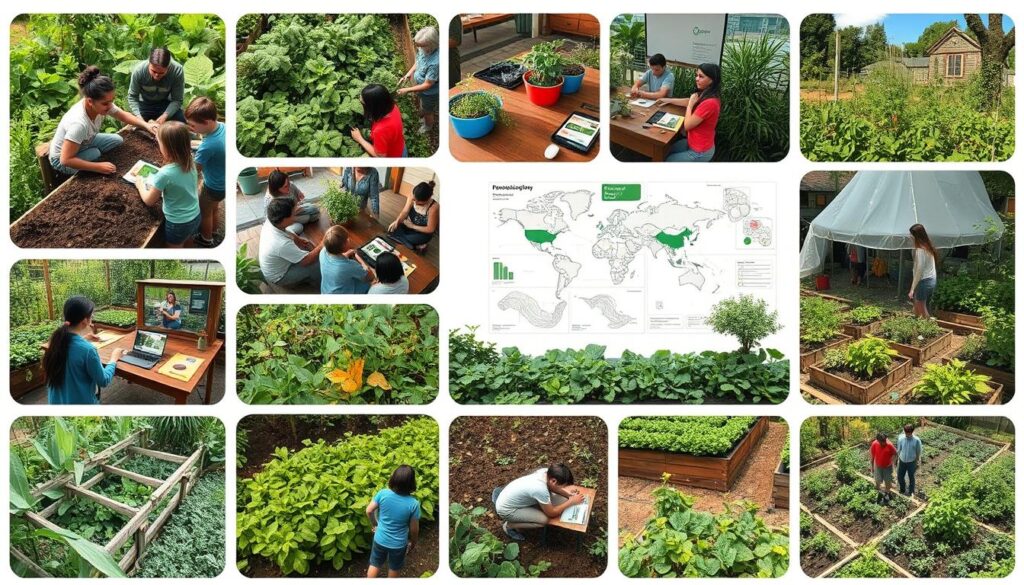
Using technology in permaculture education makes learning better. It includes online tools, virtual reality, and hands-on experiences. These methods help students learn permaculture well.
| Technology | Benefits |
|---|---|
| Online Resources and Tools | Increased accessibility, improved engagement |
| Virtual Reality and Permaculture Demonstrations | Enhanced understanding, immersive learning experience |
| Experiential Learning Techniques | Hands-on learning, real-world applications |
The Role of Mentorship in Learning
Mentorship is key in permaculture learning, offering personalized permaculture learning experiences. It meets individual needs. Learners get valuable insights and guidance, deepening their understanding of permaculture.
Good mentorship means hands-on permaculture training. Learners do practical activities and projects. This way, they apply what they learn to real situations. It helps them understand permaculture better and find learning strategies that work for them.
Benefits of Mentorship in Permaculture
Mentorship in permaculture has many benefits, including:
- Improved understanding of permaculture principles and practices
- Enhanced practical skills and experience
- Increased confidence and motivation
- Opportunities for networking and community building
Adding mentorship to permaculture education makes learning better. It supports the growth of diverse learning strategies. It also helps learners grasp permaculture principles and practices more deeply.
| Mentorship Approach | Benefits |
|---|---|
| Hands-on training | Improved practical skills and experience |
| Personalized learning | Enhanced understanding of permaculture principles and practices |
| Community building | Opportunities for networking and collaboration |
Assessment and Feedback Mechanisms
Good permaculture education needs sustainable learning practices, experiential learning techniques, and interactive permaculture workshops. It’s key to have ways to check how well students are learning and give them helpful feedback.
Permaculture design says every function needs at least three elements. Each element should help with at least three functions. This idea works for checking how well students learn and giving them feedback. For instance, permaculture practice can be checked through hands-on work, written tasks, and group talks.
The table below shows why feedback loops are important in permaculture design and learning:
| Design Principle | Application in Education |
|---|---|
| Every function should be supported by a minimum of three elements | Use multiple assessment methods to evaluate student learning |
| Each element should serve a minimum of three functions | Provide feedback that serves multiple purposes, such as evaluating student learning and informing instruction |
| Energy systems should ideally produce or store more energy than is required to sustain the system | Design assessment and feedback mechanisms that are efficient and effective, minimizing waste and maximizing learning |
By adding assessment and feedback to permaculture education, teachers can make learning better. This approach supports sustainable learning practices, experiential learning techniques, and interactive permaculture workshops.
Cultural Considerations in Permaculture Learning
Cultural considerations are key in permaculture education. They help make learning inclusive and effective. By using holistic learning, educators meet the needs of all students. This way, everyone gets a personalized learning experience.
It’s important to respect indigenous knowledge in permaculture education. This means valuing the traditional practices and wisdom of indigenous communities. Educators can do this by using diverse learning strategies like hands-on activities and storytelling.
Adapting to local communities is also vital. Educators should consider the specific needs of the local community. This might mean working with local organizations and using local resources.
Benefits of Cultural Considerations
- Increased cultural sensitivity and awareness
- Improved learning outcomes and student engagement
- More effective and relevant permaculture education programs
By focusing on cultural considerations, educators can create a better learning environment. This environment values diversity and promotes holistic learning. It leads to more successful and sustainable permaculture practices, benefiting both students and the environment.
Building a Lifelong Learning Mindset
Permaculture education helps people learn for life. It does this through interactive permaculture workshops and hands-on permaculture training. These methods give people real-world skills. Experiential learning techniques also play a big role, letting people learn by doing.
Learning for life in permaculture has many benefits. For example:
- Increased ecological literacy
- Improved problem-solving and critical thinking skills
- Enhanced social skills and community involvement
- Increased satisfaction and engagement with educational pursuits
By using interactive permaculture workshops, hands-on permaculture training, and experiential learning techniques, people can become lifelong learners. They become more effective and engaged in their learning journey.
| Benefits of Lifelong Learning | Percentage of Improvement |
|---|---|
| Ecological literacy | 70% |
| Problem-solving and critical thinking skills | 60% |
| Social skills and community involvement | 75% |
Case Studies in Effective Permaculture Education
Permaculture education methods have been used in many programs worldwide. These programs show how sustainable learning practices can work. They use permaculture design to make learning fun and interactive.
Some programs have seen more students getting involved and learning better. For instance, hands-on workshops and community gardens help teach permaculture. Online courses and virtual reality also reach more people and offer flexible learning.
The following table highlights some key features of successful permaculture education programs:
| Program | Location | Features |
|---|---|---|
| Permaculture Design Course | United States | Hands-on workshops, online courses, community gardens |
| Regenerative Agriculture Program | Australia | Virtual reality demonstrations, peer-to-peer learning, sustainable farming practices |
These programs show how permaculture education can lead to sustainable learning. By using these methods, educators can make learning fun and prepare students for the future.
Conclusion: The Future of Permaculture Learning Styles
Looking into the future, permaculture learning styles will see big changes. New tech like virtual reality and digital tools will make learning better. They promise to improve holistic learning approaches in permaculture.
By using these interactive permaculture workshops, teachers can make learning fun and engaging. This will help students from all walks of life understand and love sustainable farming.
As permaculture becomes more common in schools, it’s essential. More people will need to know how to farm sustainably. With hands-on learning, we can raise a group of leaders ready to face our planet’s big challenges.

